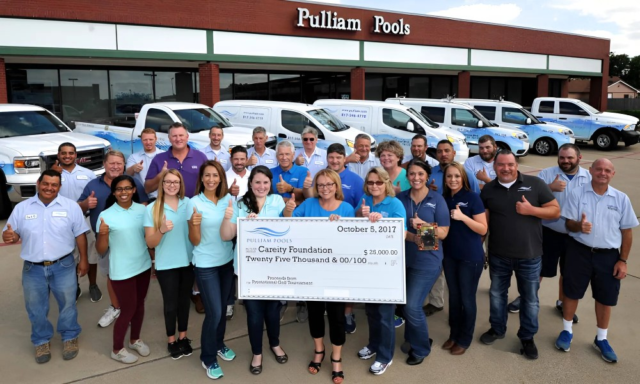The Proper Ranges for Pool Chemical Levels
Maintaining a swimming pool is all about balance. A pool that is balanced has proper levels pH, total alkalinity, and calcium hardness. Making sure pool chemicals and other factors are within their proper ranges will ensure that your pool always has clean and comfortable water. Here’s a rundown of what you should keep an eye on.
Chlorine

Chlorine: Proper Range is 1.0-3.0 PPM Chlorine level should be kept at approximately 1.5 PPM to effectively disinfect your pool water, killing bacteria and algae. Your pool may need to be super-chlorinated or shocked once or twice a month, more often in extremely hot weather to keep suntan oils from interfering with chlorine effectiveness. Never shock your pool if your pH or Total Alkalinity (TA) is not within their specified ranges!
PH

pH: Proper Range is 7.2-7.8 (Ideal is 7.4-7.6) Should be kept at 7.4-7.6 PPM. Proper pH makes your pool water compatible with your body to minimize eye irritation. pH also acts on pool equipment much the same way as TA. High pH can form scale on the pool surface and in your equipment and make chlorine less effective, low pH causes the water to become acidic and can erode your pool surface and equipment (especially heaters) as well as irritate swimmers’ eyes and skin.
Alkalinity
Total Alkalinity (TA): Proper Range 80-120 PPM Measures resistance to pH change in water, proper TA is important for four reasons:
- To make the pool water compatible with the plastered surface of your pool. Water that is too alkaline (high TA) can form scale on your pool surface and inside your equipment. Low TA water can become corrosive and could erode your pool surface and equipment.
- Proper TA will stabilize your pH so that you will not have wide swings in your pH level.
- Chlorine is also more effective when TA is in the proper range.
- Change in water volume (rain/backwashing) will affect the pH and TA.
Cyanuric Acid
Cyanuric Acid (stabilizer, conditioner): Proper Range is 60-80 PPM 80 PPM is recommended in salt pools. We initially add this at start-up and it rarely needs to be added more than once a year if you are using chlorine tabs (tablets contain cyanuric acid, therefore tablet usage tends to keep this level maintained), or quarterly if you have a salt system. This compound acts as a sunscreen for chlorine. If a proper cyanuric level is not maintained, sunlight will dissipate 95% of any chlorine added to the pool within the first hour. Stabilizer will help your pool maintain a good chlorine level and reduce chlorine usage, thus keeping chlorine expense to a minimum.
NOTE: Extremely high levels (100 PPM and above) may discolor or spot etch plaster. Check your cyanuric level quarterly to keep it from climbing too high, which may cause staining.
Calcium Hardness
Calcium Hardness: Proper Range is 200-400 PPM Everyone has heard the term hard or soft water. City water has a natural tendency to pull calcium from your pool surface. If your water is too soft, pitting and erosion can occur. If your water is too hard, mineral deposits (scale) can form on your pool surface, tile, and in your equipment.
Tips for Adding Chemicals

- Always have your pump running when adding chemicals.
- Soda Ash: Mix with water before adding to the pool. Soda Ash will cause clouding.
- Muriatic Acid: Dilute in water before adding, then hold close to the surface to reduce splash. Always add acid in the deepest part of the pool, away from lights and skimmers.
- Calcium Hypochlorite: Dilute with water to reduce clouding.
- Cyanuric Acid: Mix with warm water and pour through the skimmer. Do not backwash for 3-5 days.
- Always add chemicals to water, never add water to chemicals.
- Never mix chemicals together.
- Never add more than the recommended dose of chemicals at one time.
- Retest water no less than 4 hours after adjustment to see if more treatment is necessary.
- Do not swim during, or immediately after, adding chemicals.
- Do not store chemical containers in an enclosed space without putting them into a container.
Following these guidelines on the proper ranges for pool chemicals will make keeping your pool balanced easier. Using the tips on how to properly use pool chemicals will make them more cost-effective. Though it may seem like a lot, once you get a routine it’s simple to keep your pool water sparkling clear. If you need any help, we’re always here for you.
Pulliam Pools is a pool builder, pool renovation, and pool service provider serving Ft. Worth, Keller, Weatherford, Southlake, and the surrounding areas since 1916. Pulliam Pools is a locally and nationally recognized pool builder and pool designer, having consistently been named to the Top 50 Pool Builders by Pool & Spa News magazine, providing quality construction and superior customer service for more than 100 years.




